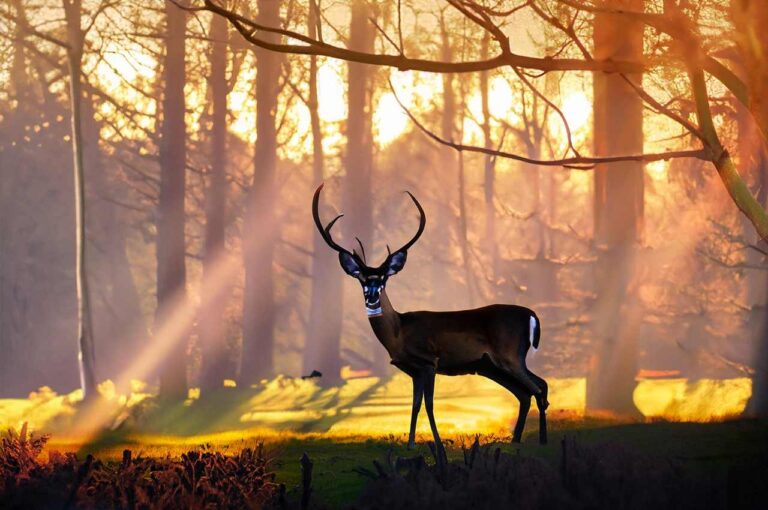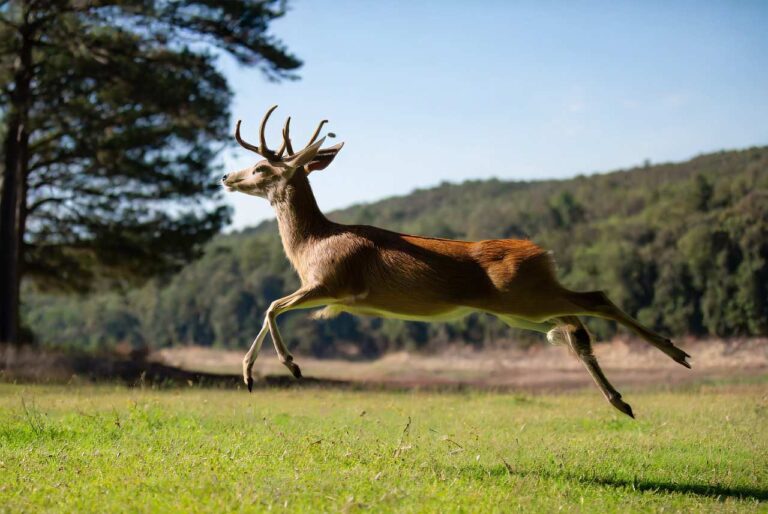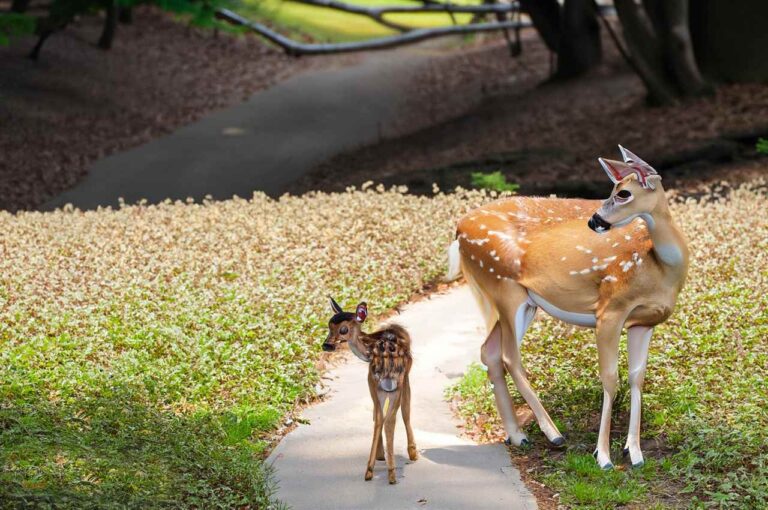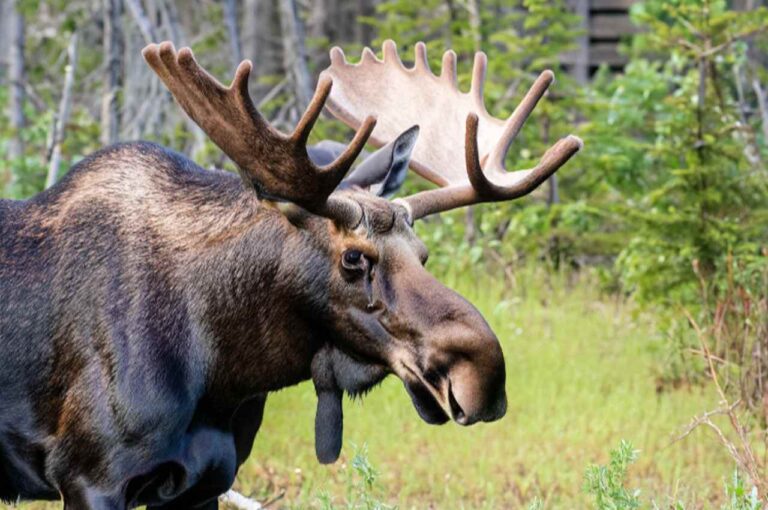When Are Deer Most Active [With Deer Movement Chart!]
Observing wildlife becomes a captivating experience when you know when deer are most active. Deer are elusive and elegant, and they display unique behavioral patterns that have long attracted both hunters and nature lovers. Deer hunters who want to improve their chances of a successful hunt, as well as wildlife lovers who want to see these animals in their natural environment, must be aware of when deer are most active. On this page, we dive into the variables that affect these beautiful creatures’ daily routines and provide insight into the activity of deer.
When are deer most active?
Deer are most active in the early morning and late evening. Though to a lesser degree, they are also active at night. Being crepuscular implies that deer are most active at night and during times of low light. Deer have exceptional vision and hearing, which offers them a competitive edge over predators at these times.
Deer are more active in the spring and summer because they need to eat more food to maintain their growing fawns and take advantage of the plentiful food supply during these times. Additionally, in the fall breeding season, deer exhibit increased movement, which often takes them close to motorways that cut across their natural habitats.
Here are some factors that can affect deer activity:
- Time of day: Dawn and dusk are the times of day when deer are most active.
- Season: The spring and summer months are when deer are most active.
- Food availability: When there is more food available, deer are more active.
- Weather: Extreme weather conditions, such as heat, cold, and rain, make deer less active.
- Hunting pressure: In places with high hunting pressure, deer are less active.
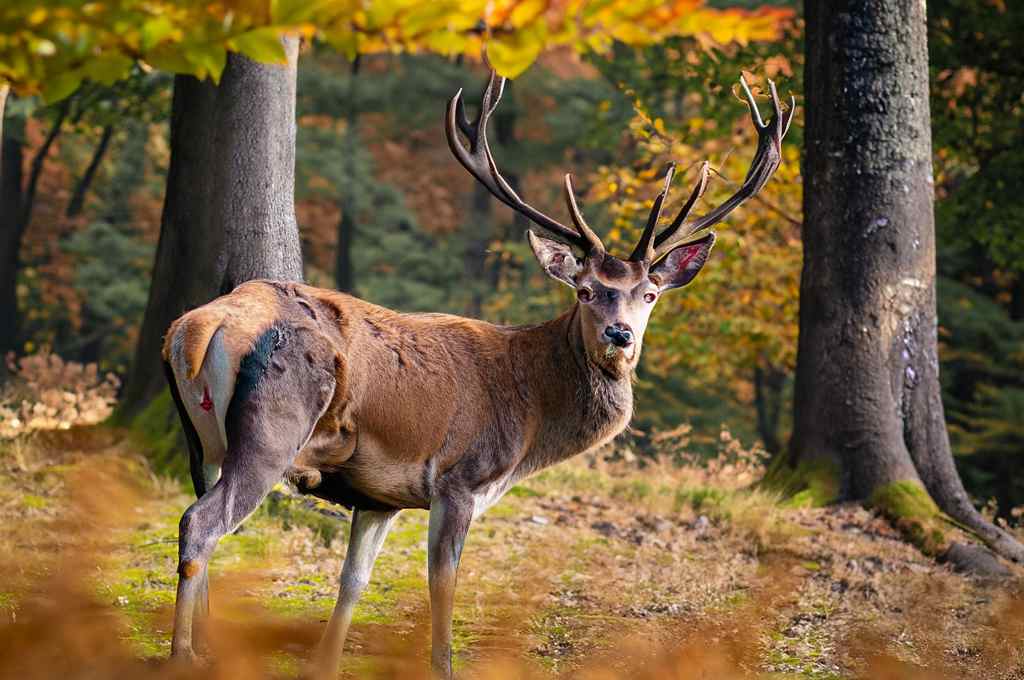
Hunters may benefit from this knowledge to raise their chances of success. Hunters may increase their chances of seeing deer by going out at dawn and dusk, as well as in the spring, summer and fall. Hunters might also aim to choose regions with plenty of food and low levels of hunting pressure.
Deer are unpredictable creatures, and their behavior may change based on a variety of variables. However, hunters may improve their odds of success by being aware of the elements that influence deer behavior.
Complete chart of deer activity by season
| Season | Time of Day | Deer Activity |
|---|---|---|
| Spring and Summer | Dawn | Most active |
| Spring and Summer | Morning | Less active |
| Spring and Summer | Midday | Least active |
| Spring and Summer | Evening | Less active |
| Spring and Summer | Dusk | Most active |
| Spring and Summer | Night | Active |
| Fall and Winter | Dawn | Less active |
| Fall and Winter | Morning | Least active |
| Fall and Winter | Midday | Less active |
| Fall and Winter | Evening | Less active |
| Fall and Winter | Dusk | Most active |
| Fall and Winter | Night | Less active |
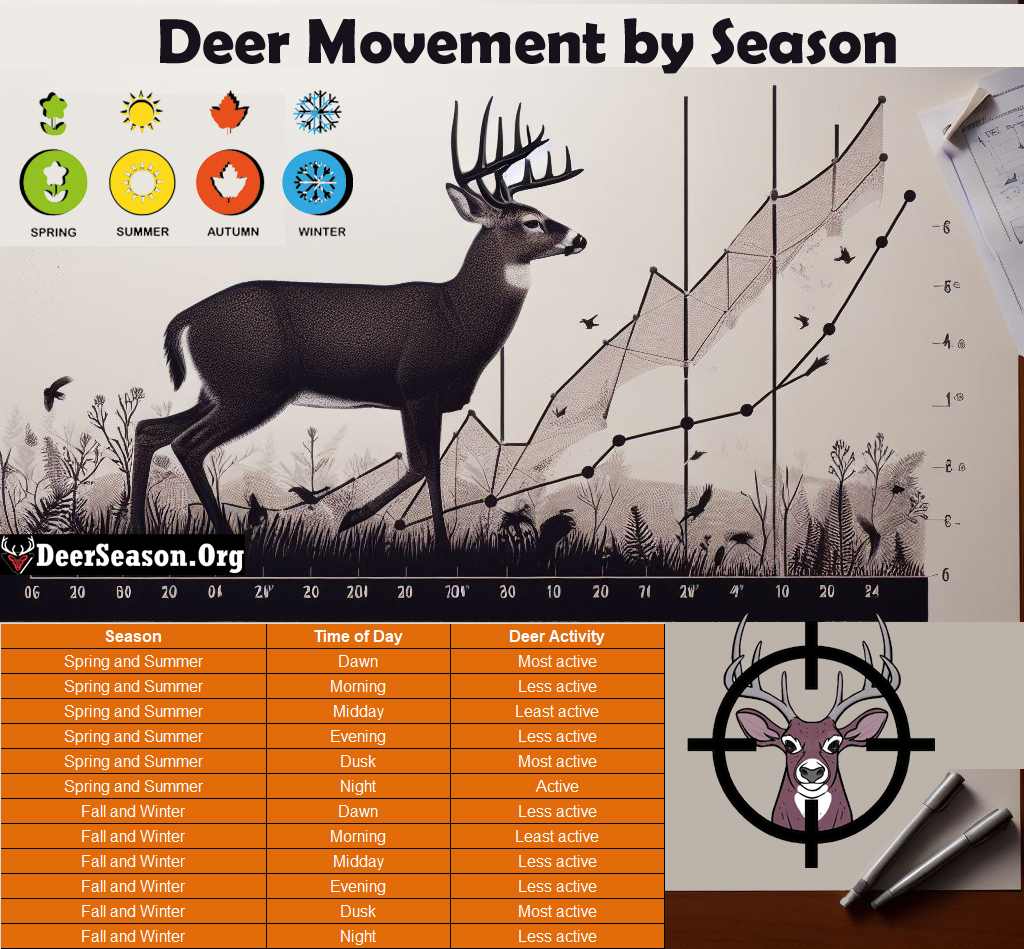
Deer Movement Chart by Time
| Season | Time | Deer Activity |
|---|---|---|
| Spring and Summer | 00:00 - 06:00 | Less active |
| Spring and Summer | 06:00 - 09:00 | Most active |
| Spring and Summer | 09:00 - 12:00 | Less active |
| Spring and Summer | 12:00 - 15:00 | Least active |
| Spring and Summer | 15:00 - 18:00 | Less active |
| Spring and Summer | 18:00 - 24:00 | Most active |
| Fall and Winter | 00:00 - 06:00 | Less active |
| Fall and Winter | 06:00 - 09:00 | Less active |
| Fall and Winter | 09:00 - 12:00 | Least active |
| Fall and Winter | 12:00 - 15:00 | Less active |
| Fall and Winter | 15:00 - 18:00 | Less active |
| Fall and Winter | 18:00 - 24:00 | Most active |
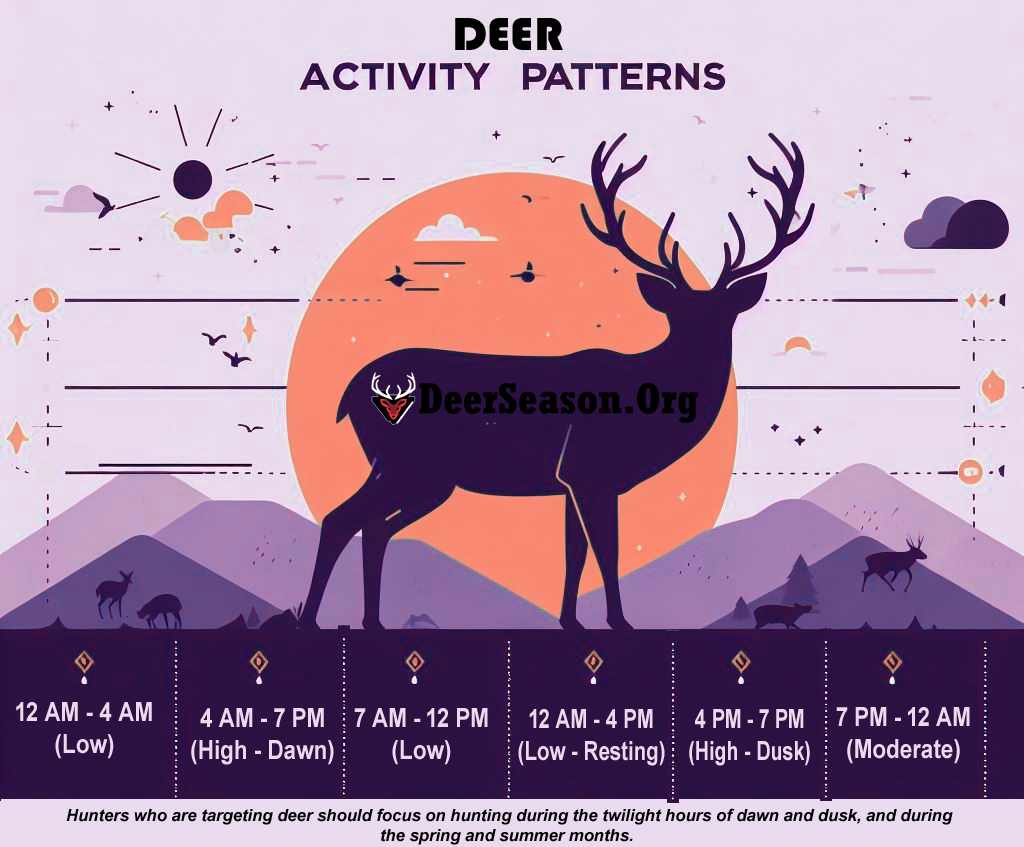
Deer Activity by Geographic Region
| Region | Deer Activity Level |
|---|---|
| Forested Areas | High |
| Grasslands | Moderate |
| Mountainous Areas | High |
| Urban Areas | Low |
Deer Activity Variables
| Factors | Impact on Deer Activity |
|---|---|
| Season (e.g., Fall) | High |
| Weather Conditions | Moderate |
| Food Availability | High |
| Human Activity (Hunting) | High |
| Predatory Threats | High |
Understanding the Activity Patterns of Deer
It’s important to know when deer are most active for hunters and wildlife lovers. Deer don’t operate on the same timetable as people; they change their activity levels throughout the day depending on a variety of circumstances. Your chances of detecting these lovely creatures may be greatly increased by developing a thorough understanding of deer behavior and movement patterns.
The Crepuscular Nature of Deer
Deer are crepuscular creatures, which means that dawn and dusk are when they are most active. In terms of evolution, this pattern of activity throughout the night makes sense. Deer move during dawn and dusk to take advantage of the lower temperatures and dim light that help conceal them from prospective predators. As the foliage is covered in dew during these times, there is also an abundance of food available.
A deer’s eyesight improves during dawn and dusk whereas predators like coyotes, wolves, and mountain lions have trouble seeing at these times. Their unique eyes enable them to detect more light at twilight and better see at dawn by refracting light. Deer have the benefit of being active when their predators are less effective hunters.
Prime Times of Deer Movement
Although deer are most active at dawn and dusk, their activity might change depending on the season. The maxima of deer migration throughout each season are listed below:
- Spring: Deer are recuperating from the pressures of winter in the spring. Additionally, there are more and more food options available. Deer will be active in the morning and the evening, but when they recover their vigor, they may also graze more throughout the day.
- Summer: In the summer, when there is an abundance of food, deer activity is centered between dawn and dusk. They may preserve energy by being less active during the hottest part of the day. Does are also getting ready for the fawning season.
- Fall: The height of mating season and bucks entering their rut make the fall a thrilling period. To find partners, deer are quite active throughout the day. Deer tend to stay in dense cover during shooting hours as a result of hunting pressure.
- Winter: Due to the shorter days and cooler temperatures, deer are more likely to feed during the day. Deep snow, however, might make it difficult to maneuver during the midday. Deer are still nocturnal, but when circumstances permit, they may sometimes be active throughout the day.
The Effects of Weather on Deer Movement
Deer activity patterns may be affected by changes in temperature, precipitation, moon phase, and other meteorological factors. Here are a few instances:
- Cold Temperatures – Deer are more likely to be active in colder weather because they need to forage more to fulfill their increased caloric needs.
- Rain – While a little drizzle may not have much of an effect, heavier rain will slow deer movement. After a shower, deer will start moving again when the weather is better.
- Wind – Since deer depend more on their vision for protection in strong gusts, mobility is actually increased.
- Fronts – Deer may increase forage in advance of a front to prepare. Cooler temperatures cause higher activity after a front passes.
- Snow – Until paths are developed, movement will be restricted after heavy snowfall. To save energy, deer will stay on paths.
- Moon Phase – Although many hunters think the moon affects deer behavior, research have shown no link between moon phase or brightness and deer movement.
Understanding daily and seasonal variations in deer behavior depends heavily on paying attention to the weather prediction. Their patterns are fairly predictable, although daily unpredictability is brought on by the weather.
Effects of Food Sources on Activity Levels
The location of preferred food sources is another element that affects the migration of deer. Deer will go to extreme lengths to locate the nutrition they need. Food has an effect on how active they are during the day:
- Deer may emerge sooner or remain active longer throughout the day in places containing agricultural crops like soybeans, maize, and alfalfa in order to reach these fields.
- Deer will spend more time foraging beneath oak trees in the morning and afternoon in the autumn when the acorns are ready.
- Deer are more routinely drawn out into openings throughout the day by food plots that hunters have established.
- When natural forage is covered by snow in the winter, deer go out in the middle of the day in search of food.
- In times of food scarcity, deer may come out of hiding at times other than dawn and dusk.
Understanding the local deer eating habits and food sources might help you anticipate when the animals will migrate.
Rutting Behavior Changes Activity Patterns
When the rut, or mating season, is at its height, bucks become more active as they look for estrous does. For a few weeks in the autumn, bucks disregard their instincts as the desire to mate dominates them.
Bucks will travel throughout the day and night during the rut in search of hot does. They often come out of hiding in the middle of the day, and they have even been seen looking for females at night. Additionally, hunting pressure affects rutting bucks, making them nocturnal in densely hunted ground.
Midday and late evening during peak rut are the best times to be out in the field if your objective is to watch rutting activity or capture a mature buck. At this period, bucks check, rub, and pursue does.
Effects of Human Behavior on Deer
Deer activity patterns often change when suburban areas encroach into their natural habitats as a result of human activities. Several instances include:
- Yard work – During the day on weekends when people are at home, noise from lawn mowers, leaf blowers, etc. may drive deer into cover.
- Hunting Pressure – During hunting season, deer change their behavior to evade hunters by moving during the night or at early light.
- Artificial lighting – Excessive nighttime illumination makes it possible for deer to be active later into the evening and affects their circadian cycles.
It is recommended to keep an eye on deer activities in wilderness regions far from direct human effects in order to study their natural behavior. However, it is useful to comprehend how nearby human activity upsets deer in order to predict their behavior.
Using Cameras to Pattern Deer Movement on Your Property
For recording deer behavior on a plot of land objectively across time, trail cameras are a great tool. Install cameras to capture images of important regions such as feeding plots, wildlife routes, sleeping areas, or rub lines.
Looking at the timestamp on deer images might provide you specific information about when deer are active in that area. This may be used to demonstrate how activity levels vary depending on the time of day, the weather, hunting pressure, the availability of food, and other things.
For serious hunters, game cams have become a necessary piece of gear. The knowledge they provide helps in choosing the best times to go out in the field. Additionally, they enable you to determine if disturbances such as ATV usage or dog walking affect deer migration after the fact.
Insights from In-the-Field Experiences and Personal Perspectives on Deer Activity
| Personal Insights | Description |
|---|---|
| Hunter's Dawn Perspective | Deer hunting is a traditional art. Hunting deer in the morning while they're active is thrilling. |
| Understanding Deer's Clock | Dawn-active deer follow lunar cycles. Understanding these patterns improves observing wildlife. |
| Observing Deer at Dusk | Dusk intrigues nature lovers. Deer produce extended shadows, revealing social dynamics and feeding patterns. |
| Patience for Dusk Observations | Dusk deer viewing needs patience and heightened senses. Seeing a deer at dusk is priceless. |
| Year-Round Deer Activity | Spring and summer see deer moving for food and mating, whereas autumn and winter show a different side. |
| Deer in Ecosystem Harmony | Deer are important for environmental equilibrium during dawn and dusk. Their interactions with other animals and plants show the complex dance of nature. |
| Wildlife Conservation Perspective | Conservation activities need knowledge about deer's daily habits. Protecting these events for future generations is shared. |
| Deer's Adaptability | Deer adapt well to daytime predators and hard winters. Their activity reveals their evolutionary strength. |
| Feeding Habits at Dawn and Dusk | Deer's dawn and dusk eating routines are interesting and help us understand their nutrition. |
| Contributing to Deer Conservation | Observing deer in the countryside goes beyond fun. These fascinating species' survival depends on careful observation, documentation, and support for local conservation initiatives. |
Frequently Asked Questions
1. Are deer truly nocturnal, or do they have specific times when they are most active?
Deer are crepuscular animals, which means they are most active at dawn and dusk, contrary to popular belief that they are nocturnal animals. They are less active at night and throughout the majority of the day.
2. Do deer prefer to be active in the morning or the evening?
Dawn is often when deer are most active, making it a popular time for hunting. The second busiest hour is dusk. The choice could change based on the area and season.
3. How does the weather impact the behavior of deer?
Deer activity is significantly influenced by the weather. They may become more active, more likely to hunt food or remain warm in colder weather. Their activity may be decreased by rain, but it may be increased by windy days. Hunting requires careful consideration of the weather.
4. What factors influence deer activity during the rut (mating season)?
Deer are more active in the afternoons during the rut than they are during other times of the year. Bucks are aggressively seeking mates and battling for supremacy. The time of this season might vary by area, although it usually happens in the the fall season.
5. How does deer behavior differ on clear days vs cloudy days?
Deer activity may drop throughout the middle of the day on clear days, although it may increase in the mornings and nights. Deer often move more during the middle of a cloudy day since it’s a little bit darker.
6. How does rain affect deer movement?
Deer find it more difficult to identify predators when it rains because it affects their senses, especially scent and hearing. When it stops raining after a moderate downpour, deer may relocate to clearings or fields. Intense rain may drastically slow down mobility.
7. How do deer respond to approaching storm fronts?
Deer are able to smell coming storms and may eat more voraciously before one to avoid moving while it is occurring. They are more likely to return to food sources after the storm since they are hungry.
8. Do moon phases affect deer activity?
Moon phases are a contentious subject, but there isn’t any solid proof that they really have an impact on how deer travel. However, depending on the amount of moonlight, some hunters could change their hunting schedules.
9. Does the barometric pressure affect the behavior of deer?
Movement of deer may be impacted by barometric pressure. Deer often move more than normal when the pressure is between 30.2 and 30.5 in-Hg. Deer may start feeding early if low pressure is an indication of adverse weather.
10. What are the best times to hunt deer based on their activity patterns?
Deer are most active at dawn and dusk, making those hours the ideal for hunting. To avoid being seen, you must be in place before the deer begin active. Hunting success may be increased by knowing their behaviors and taking the weather into account.
11. How long are deer typically active during dawn and dusk?
Dawn and dusk are often the times of day when deer are most active. They go the furthest and are most likely to be moving at these times. The bulk of the day is spent sleeping and eating, with peak activity patterns fluctuating significantly according on the season and other elements like the weather. During the evening, beginning around sunset and continuing into the night, deer often leave their sleeping sites. The greatest activity usually takes place between 4:00 pm and 7:00 pm. Deer normally rest between 12:00 pm and 4:00 pm during the day, whereas bucks in particular are more active at night and in the evening. Dawn and dusk typically indicate the principal peaks of deer movement. This activity pattern is governed by several elements such as season, pressure, and weather conditions.
Conclusion
Although deer are undoubtedly animals of dawn and twilight, a variety of factors affect how active they are throughout the day. The interaction of weather patterns, breeding habits, food availability, and human presence influences their behavior. The best wildlife observers and hunters are able to get this knowledge and take use of it. Your chances and pleasure of the time spent following whitetails will increase if you become an expert on when deer are most active.
- Wyoming Deer Season 2025-2026 New Schedule & Rules - 15 September 2025
- Wisconsin Deer Season 2025-2026: WI Deer Hunting Guide [Schedule, Rules, Licenses] - 15 September 2025
- West Virginia Deer Season 2025-2026 Complete Date & Guide - 15 September 2025


